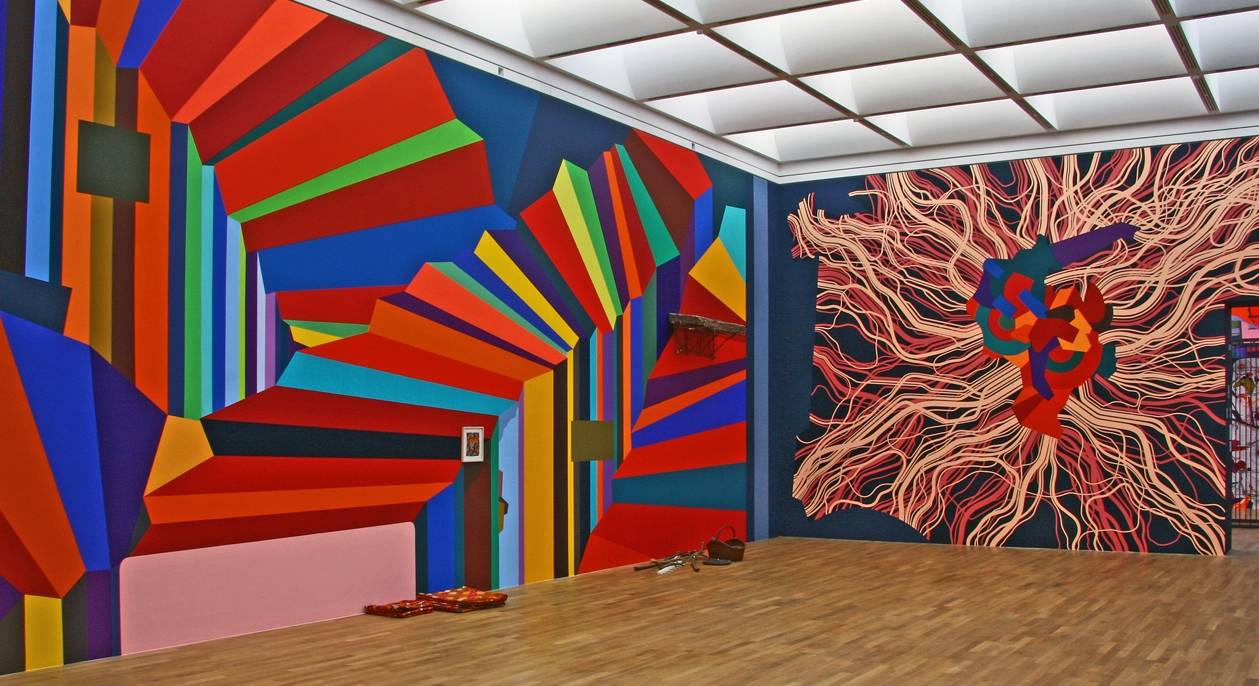Franz Ackermann and the Faena Arts Center Laboratory of Artistic Experimentation
The painter Franz Ackermann and the Laboratory of Artistic Experimentation present their work in the Faena Arts center of Buenos Aires, beginning this November 9.
Beginning November 9, 2012, the Molinos Hall of Faena Arts Center presents the work, Walking South, by the German Artist Franz Ackermann. It’s a “mental map” in the form of an enormous mural of 260 square meters, inspired by the recent visit the painter made to Buenos Aires.
Made from the merging of 21 panels, Walking South synthesizes, as its name proclaims, Ackermann’s experience as a sojourner in the port city––as someone who walked its streets and, by doing so, followed the spontaneous course of daily life.
The artist describes his experience:
I went on daily walks from La Boca to Palermo for ten weeks and I also rode my bike next to the Rio de la Plata. I took the train to the last station and came back walking until I felt that what surrounded me was sufficiently interesting. It’s not that I found interesting things in every moment: just daily life. There was boredom, sun, rain, good and bad streets. Sometimes a very poorly made coffee; though brilliant, usually. I like anonymity. I like this form of urbanism in which you’re only a part of a very complicated situation. Walking down Once street you can feel the various layers of economy, time, fashion, tendencies. Observing people is very interesting.
Walking South is today the largest piece of work in Ackermann’s career: a journey on horseback between reality and the urban poetry of pictorial, geographic and architectural spaces of the Argentine capital. At the same time, the Laboratory of Artistic Experimentation—a Faena Arts Center initiative—will open the Cathedral Hall to present the results of the first edition of the research created by Ximena Caminos and directed by the Argentine artists Emiliano Miliyo, Diego Bianchi and Inés Dahn.
The exhibition is the result of the dialogical and experimental work of nine artists: Nicanor Araoz, Ernesto Ballesteros, Julián d’Angiolillo, Irina Kirchuk, Valentina Liernur, Lucrecia Lionti, Adriana Minoliti, Dudú Quintanilha and Luis Terán, who within tree months generated a creative process characterized by the interweaving of various disciplines and artistic perspectives. Ximena Caminos, Executive Director of Faena Arts Center, said:
We created L.E.A to generate a space of experimentation protected from social and commercial pressures. L.E.A is a laboratory, a place in which trial and error are equally or more important than the result. The interesting thing about this project is the interaction and collaboration among artists of such different backgrounds, working in the face of the challenge to make something with common ground.
Both exhibitions acknowledge the central role that Faena Arts Center has acquired in the cultural life of the people of Buenos Aires. This is an opportunity to get a closer look to the explorations that are being made by contemporary artists.
Related Articles
Pictorial spiritism (a woman's drawings guided by a spirit)
There are numerous examples in the history of self-taught artists which suggest an interrogation of that which we take for granted within the universe of art. Such was the case with figures like
Astounding fairytale illustrations from Japan
Fairy tales tribal stories— are more than childish tales. Such fictions, the characters of which inhabit our earliest memories, aren’t just literary works with an aesthetic and pleasant purpose. They
A cinematic poem and an ode to water: its rhythms, shapes and textures
Here lies One Whose Name was writ in Water. - John Keats Without water the equation of life, at least life as we know it, would be impossible. A growing hypothesis holds that water, including the
Watch beauty unfold through science in this "ode to a flower" (video)
The study of the microscopic is one of the richest, most aesthetic methods of understanding the world. Lucky is the scientist who, upon seeing something beautiful, is able to see all of the tiny
To invent those we love or to see them as they are? Love in two of the movies' favorite scenes
So much has been said already, of “love” that it’s difficult to add anything, much less something new. It’s possible, though, perhaps because even if you try to pass through the sieve of all our
This app allows you to find and preserve ancient typographies
Most people, even those who are far removed from the world of design, are familiar with some type of typography and its ability to transform any text, help out dyslexics or stretch an eight page paper
The secrets of the mind-body connection
For decades medical research has recognized the existence of the placebo effect — in which the assumption that a medication will help produces actual physical improvements. In addition to this, a
The sea as infinite laboratory
Much of our thinking on the shape of the world and the universe derives from the way scientists and artists have approached these topics over time. Our fascination with the mysteries of the
Sharing and collaborating - natural movements of the creative being
We might sometimes think that artistic or creative activity is, in essence, individualistic. The Genesis of Judeo-Christian tradition portrays a God whose decision to create the world is as vehement
John Malkovich becomes David Lynch (and other characters)
John Malkovich and David Lynch are, respectively, the actor and film director who’ve implicitly or explicitly addressed the issues of identity and its porous barriers through numerous projects. Now










